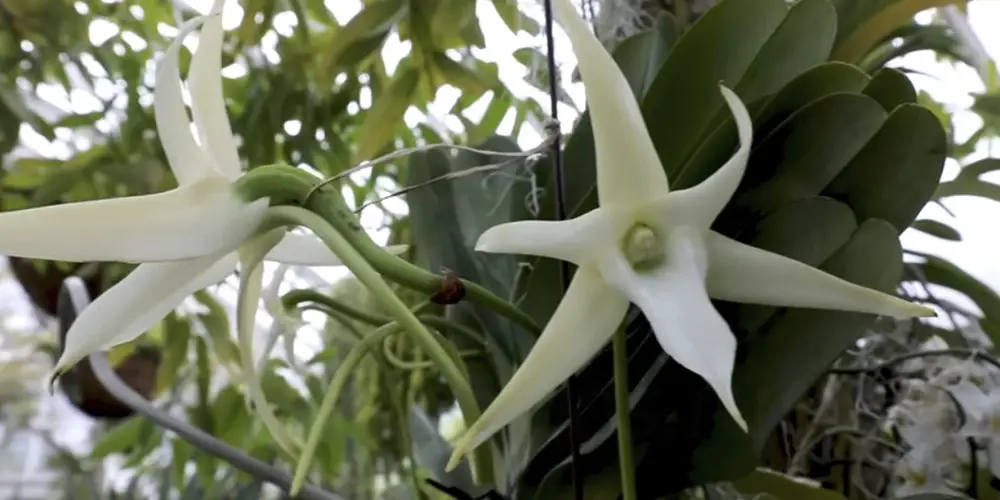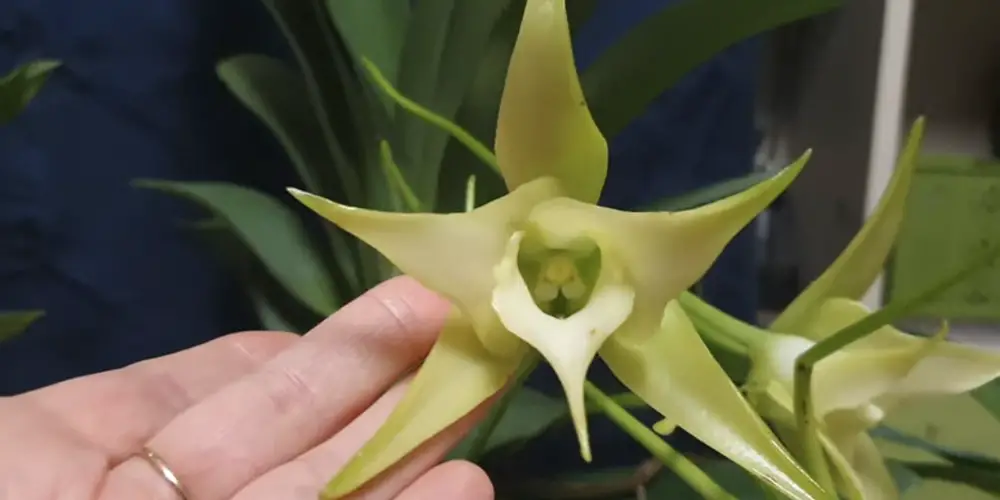It was first discovered in Madagascar in 1798 by a French botanist. Angraecum Sesquipedale means one and a half feet Angraecum. Received this name because of the structure of the flower, the ratio of the size of the spur to the petals. Has several names.
For example, in England, they call the “comet orchid”, in France “Star of Madagascar Orchid”, “Christmas Orchid” blooms for Catholic Christmas also named as “Darwin’s Orchid“. Indeed, the shape of the flower is very much like a star. A comet because of the long “tail” of the flower.

where Angraecum Sesquipedale orchid found in nature: Growing places
In former times, the orchid was found in the southern part of Madagascar, near the lying islands, southeast Africa, in the west of Australia, Indonesia. Currently, it is on the verge of extinction, despite attempts to increase the number and habitat. Inhabits up to 500 meters above sea level, on fallen trees, stumps, rock crevices.
There are epiphytic varieties, rarely lithophytes. Even less often – growing on the ground.
Some copies were brought to England in 1855. Only in 1859 did it bloom for the first time. The first hybrid was bred 44 years later, in 1899. Received the name “King of the Angraceum” (King of the Angraceum). Subsequently, many primary and intergeneric hybrids were bred.
Must check out our guides about Renanthera Kalsom and Habenaria Radiata.
Angraecum Sesquipedale Orchid Discreption
The orchid is rather large, reaching a height of 70-90 cm. There are also miniature species. Refers to the monopodial type of growth. The leaves are narrow, about 40 cm long, wax-coated, with blunt edges. On a short peduncle, 2-5 flowers are formed. The diameter of the flower is about 15 cm, resembling a star in shape. The petals are pointed, slightly bent back. The lip is elongated, pointed.
A peculiarity of the genus is the elongated sepal at the flower (spur), intended for the accumulation of nectar. Reaches a length of 30 cm. The column is thickened.
The roots are thick, silvery-green, with a green, brown tint at the edges. Aerial species of roots sometimes grow on the trunk. Does not have a pronounced rest period. Belongs to the Vanda group, the appearance of the green mass strongly resembles Wanda.
The Angrekum orchid belongs to the moderately warm group.
interesting fact about Angraecum Sesquipedale
The genus Angrekum became famous thanks to Charles Darwin, who described this species in his book on the various adaptations of Orchids for insect pollination. He suggested that this orchid most likely has its own kind of pollinator with a long proboscis, which is able to get nectar from a long spur.
After the death of the scientist, his words were confirmed. In Africa found a pollinator with a long 25 cm probosci’s hawk moth (butterfly) called “Xanthopan Morganii“. The wingspan is 15 cm.
Angraecum Sesquipedale Flowering Care
Usually, the flowering period in nature occurs in the summer-autumn time. The flowering period of Angrekum is 2-3 months. Depending on the conditions of detention, it can bloom twice a year – in winter and summer. The flowers have a strong scent, reminiscent of lilies of the valley.
The aroma is emitted only at night. The main color scheme is white, cream.

Temperature and humidity
The habitat allows us to determine the appropriate temperatures at which Angraecum sesquipedale grows well.
In winter, the temperature in Madagascar does not drop below +15 degrees at night. The daytime temperature rises to 20 C.
In the spring, at night, the temperature regime at night is about 20 degrees, in the daytime it is 25 degrees.
In summer, the temperature reaches 30 degrees during the daytime, at night it is 5-10 degrees cooler. The climate is tropical, with high humidity, as it often rains.
Home conditions must be created close to natural conditions with a humidity index of at least 60-70%.
Read also about Types Of Phalaenopsis Orchids.
Lighting
Lighting must be bright with the obligatory shading from the direct rays of the sun. Although the leaves are protected by a waxy coating, it still does not exclude the appearance of burns on the leaves.
In winter, you need to organize backlighting for at least 10-12 hours a day. Lack of brightness and duration of lighting affects flowering. It stops blooming. The light intensity is brighter than for phalaenopsis.
Watering
Watering should be carried out only with clean water, warm. Slightly warmer than room temperature. The roots are sensitive to salts, so it is always worth monitoring the water quality and the frequency of fertilization. It appears in the form of spots on the leaves of a dark color and a white bloom on the substrate.
The watering schedule depends on the planting method, season, temperature, humidity. Angrekum one and a half feet loves moisture, the soil should not dry out completely between waterings. It is better for the plant to always be slightly moist. The watering method is soaking, spraying, or shedding.
Fertilizers
Complex fertilizers intended for orchids are suitable for fertilizing. Fertilize one to three times a month in a low concentration. No fertilization is required during the flowering phase.
Transfer
Transplant once every three years. Depends on the condition of the soil. If the substrate did not have time to decompose, compact, saline, then the orchid transplant can be postponed. After braking the roots, it can fall asleep for several months.
Suitable for planting bark of medium, the coarse fraction with the addition of moss. Collectors successfully grow both in inorganic soils and simply in sphagnum moss.
Moss is carefully changed to a new one every year. Place in a pot with drainage holes, a basket, on a block. Any of these options will work, the main thing is that air can freely penetrate the roots.
Reproduction
At home, it reproduces by children and by dividing the bush. Babies appear at the base. The bush is divided into upper and lower parts when the trunk is elongated and has many aerial roots.
Pests, diseases
The flower is most often affected by varieties of ticks, scale insects and false scales, different types of fungi.
The fight against such manifestations consists in treating the orchid with special preparations against insects, ticks and diseases. The sooner the problem is found, the better.
Our latest guide on Maxillaria Orchid.
Angraecum Sesquipedale Varieties
There are famous varieties of Angraecum sesquipedale:
- Angraecum sesquipedale
- Angraecum scottianum
- Angraecum “Party Girl”
- Angraecum eburneum
- Angraecum Veitchii
